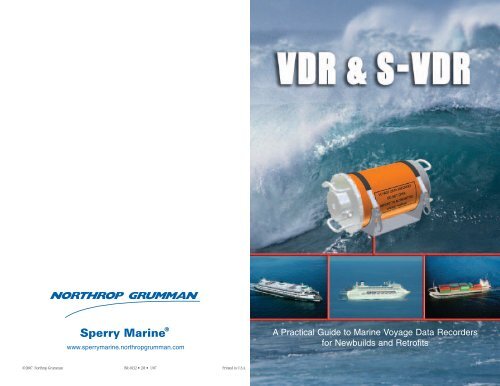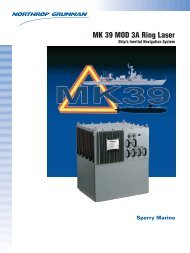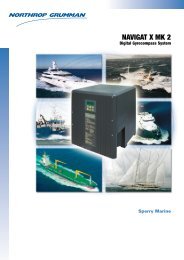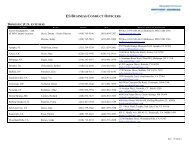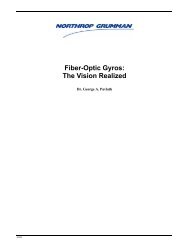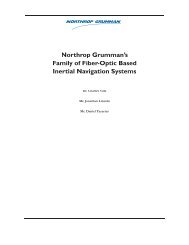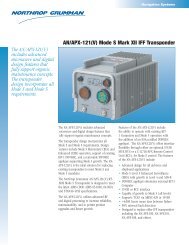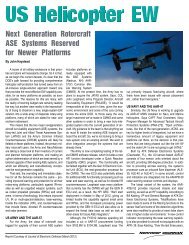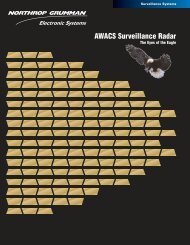A Practical Guide to Marine Voyage Data Recorders for Newbuilds ...
A Practical Guide to Marine Voyage Data Recorders for Newbuilds ...
A Practical Guide to Marine Voyage Data Recorders for Newbuilds ...
Create successful ePaper yourself
Turn your PDF publications into a flip-book with our unique Google optimized e-Paper software.
www.sperrymarine.northropgrumman.com<br />
©2007 Northrop Grumman BR-0132 • 2M • 1/07 Printed in U.S.A.<br />
A <strong>Practical</strong> <strong>Guide</strong> <strong>to</strong> <strong>Marine</strong> <strong>Voyage</strong> <strong>Data</strong> <strong>Recorders</strong><br />
<strong>for</strong> <strong>Newbuilds</strong> and Retrofits
Table of Contents<br />
Chapter 1. Black Boxes <strong>for</strong> Ships<br />
Chapter 2. Carriage Requirements<br />
Chapter 3. Per<strong>for</strong>mance Standards<br />
Chapter 4. Interface Requirements<br />
Chapter 5. Protected <strong>Data</strong> Capsules<br />
A <strong>Practical</strong> <strong>Guide</strong> <strong>to</strong><br />
<strong>Marine</strong> <strong>Voyage</strong> <strong>Data</strong> <strong>Recorders</strong><br />
<strong>for</strong> <strong>Newbuilds</strong> and Retrofits<br />
Chapter 6. Ownership and Recovery of VDR <strong>Data</strong><br />
Chapter 7. Commissioning and Certification<br />
Chapter 8. Beyond the Black Box<br />
Chapter 9. Solutions <strong>for</strong> <strong>Newbuilds</strong> and Retrofits
1<br />
CHAPTER 1<br />
Black Boxes <strong>for</strong> Ships<br />
For a good many years, data and cockpit voice recorders have<br />
been required on commercial aircraft. These “black box” devices –<br />
which are actually bright orange – have been invaluable <strong>to</strong>ols <strong>for</strong><br />
investigating accidents and determining remedial actions.<br />
In the 1980s, several major maritime disasters, notably the sinking<br />
of the passenger ship Es<strong>to</strong>nia with the loss of more than 900 lives,<br />
led the maritime industry <strong>to</strong> consider adopting similar technology <strong>for</strong><br />
ships. As a result, during the 1990s the International Maritime<br />
Organization (IMO) developed specifications <strong>for</strong> a marine <strong>Voyage</strong><br />
<strong>Data</strong> Recorder (VDR), which would record and s<strong>to</strong>re data from shipboard<br />
sensors and systems, as well as voice recordings from the bridge<br />
and VHF radio communications, <strong>for</strong> retrieval after an incident at sea.<br />
IMO Resolution A.861 (20) was adopted by the IMO in May 1999.<br />
It established a deadline of 2002, after which new ships must be fitted<br />
with an approved VDR. The VDR carriage requirements included<br />
retrofits <strong>to</strong> passenger and ro-ro passenger ships built be<strong>for</strong>e 2002,<br />
but did not provide <strong>for</strong> retrofits <strong>to</strong> older non-passenger cargo ships.<br />
In 2005, the IMO amended Resolution A.861 <strong>to</strong> add a requirement<br />
<strong>for</strong> retrofitting a Simplified VDR (S-VDR) on all existing cargo ships<br />
over 3,000 gross <strong>to</strong>ns. The modified specification <strong>for</strong> the S-VDR recognizes<br />
the difficulties in interfacing <strong>to</strong> the existing analog sensors on<br />
older ships.<br />
The VDR or S-VDR is designed <strong>to</strong> record and s<strong>to</strong>re, in a secure<br />
and retrievable <strong>for</strong>m, in<strong>for</strong>mation concerning the ship’s position,<br />
movement, physical status and command and control <strong>for</strong> the period<br />
leading up <strong>to</strong> and following an incident. The data must be s<strong>to</strong>red<br />
au<strong>to</strong>matically in an approved protective capsule.<br />
In this booklet, we will explain the carriage requirements, per<strong>for</strong>mance<br />
standards, interfacing requirements and certification procedures <strong>for</strong><br />
VDRs and S-VDRs.<br />
2
2<br />
CHAPTER 2<br />
Carriage Requirements<br />
VDR and S-VDR carriage requirements are spelled out in IMO<br />
Resolution A.861 (20), “Standards <strong>for</strong> Shipborne <strong>Voyage</strong> <strong>Data</strong><br />
<strong>Recorders</strong>.”<br />
To assist in casualty investigations, ships, when engaged on international<br />
voyages subject <strong>to</strong> the provisions of regulation 1.4, shall be<br />
fitted with a voyage data recorder (VDR) as follows:<br />
• Passenger ships constructed on or after 1 July 2002<br />
• Ro-ro passenger ships constructed be<strong>for</strong>e 1 July 2002, not later<br />
than the first survey on or after 1 July 2002<br />
• Passenger ships other than ro-ro passenger ships constructed<br />
be<strong>for</strong>e 1 July 2002, not later than 1 January 2002<br />
• Ships other than passenger ships, of 3,000 gross <strong>to</strong>nnage and<br />
upwards, constructed on or after 1 July 2002<br />
Thus, all existing passenger and ro-ro passenger ships, and all<br />
new cargo ships of 3,000 or more gross <strong>to</strong>ns built since 1 July<br />
2002, are now required <strong>to</strong> be fitted with a VDR.<br />
The IMO Resolution was amended in 2005 <strong>to</strong> add the following<br />
carriage requirements <strong>for</strong> retroffiting existing cargo ships with a<br />
VDR, which may be a simplified VDR (S-VDR).<br />
• In the case of cargo ships of 20,000 gross <strong>to</strong>nnage and upwards<br />
constructed be<strong>for</strong>e 1 July 2002, at the first scheduled drydocking<br />
after 1 July 2006, but not later than 1 July 2009.<br />
• In the case of cargo ships of 3,000 gross <strong>to</strong>nnage and upwards<br />
but less than 20,000 gross <strong>to</strong>nnage constructed be<strong>for</strong>e 1 July 2002,<br />
at the first scheduled drydocking after 1 July 2007, but not later<br />
than 1 July 2010.<br />
Administrations may exempt cargo ships from the application of the<br />
carriage requirements when such ship will be taken permanently<br />
out of service within two years after the implementation date.<br />
Administrations may also exempt ships, other than ro-ro passenger<br />
ships, constructed be<strong>for</strong>e 1 July 2002 from being fitted with a VDR<br />
where it can be demonstrated that interfacing a VDR with the existing<br />
equipment on the ship is unreasonable and impractical.<br />
The VDR or S-VDR required by these regulations must meet<br />
per<strong>for</strong>mance standards that are not inferior <strong>to</strong> those adopted by the<br />
IMO, and must be type approved in accordance with procedures<br />
spelled out in IMO A.861 (18).<br />
Ship Type New ships built on or<br />
after 1 July 2002<br />
Passenger VDR VDR<br />
Ro-Ro Passenger VDR VDR<br />
Cargo Ships over 20,000<br />
grt<br />
Cargo Ships 3,000-<br />
20,000 grt<br />
Existing ships built be<strong>for</strong>e<br />
1 July 2002<br />
VDR S-VDR at 1st drydocking<br />
after 1 July 2006, but not<br />
later than 1 July 2009<br />
VDR S-VDR at 1st drydocking<br />
after 1 July 2007, but not<br />
later than 1 July 2010<br />
4 5
3<br />
CHAPTER 3<br />
Per<strong>for</strong>mance Standards<br />
Detailed per<strong>for</strong>mance standards <strong>for</strong> VDRs and S-VDRs are contained<br />
in IEC 61996, published by the International Electrotechnical<br />
Commission.<br />
The per<strong>for</strong>mance standards state that the VDR or S-VDR should<br />
continuously maintain sequential records of preselected data items<br />
relating <strong>to</strong> the status and output of the ship’s equipment and<br />
command and control of the ship.<br />
The specification <strong>for</strong> S-VDR differs from that <strong>for</strong> the VDR in two areas:<br />
• The requirements <strong>for</strong> moni<strong>to</strong>ring certain sensors are reduced<br />
when the data is not provided in IEC 61162 <strong>for</strong>mat.<br />
• The requirements <strong>for</strong> the protective S-VDR capsule are different<br />
from the VDR capsule, both <strong>for</strong> the fixed and float-free versions.<br />
Both the VDR and S-VDR are required <strong>to</strong> record date and time,<br />
ship’s position, speed and heading, bridge and VHF audio and<br />
radar playback. In the case of the S-VDR, AIS output may be an<br />
acceptable substitute <strong>for</strong> the radar picture under certain circumstances.<br />
Additional data sources are required with the full VDR.<br />
See Chapter 4 <strong>for</strong> a detailed listing of VDR and S-VDR interface<br />
requirements.<br />
The final recording medium <strong>for</strong> a VDR or S-VDR should be installed<br />
in a protective capsule of either a fixed or float-free type, which<br />
should meet all of the following requirements:<br />
• Be capable of being accessed following an incident but secure<br />
against tampering<br />
• Maintain the recorded data <strong>for</strong> a period of at least 2 years following<br />
termination of recording<br />
• Be fitted with an appropriate device <strong>to</strong> aid location<br />
See Chapter 5 <strong>for</strong> detailed specifications <strong>for</strong> protective data capsules.<br />
The VDR or S-VDR equipment must be designed so that, as far as<br />
is practical, it is not possible <strong>to</strong> tamper with the selection of data<br />
being input <strong>to</strong> the equipment, the data itself nor that which has already<br />
been recorded. Any attempt <strong>to</strong> interfere with the integrity of the<br />
data or the recording should be recorded.<br />
The recording method should be such that each item of the recorded<br />
data is checked <strong>for</strong> integrity and an alarm given if a non-correctable<br />
error is recorded.<br />
To ensure that the VDR or S-VDR continues <strong>to</strong> record events during<br />
an incident, it should be capable of operating from the ship’s<br />
emergency source of electrical power. If the ship’s emergency<br />
power fails, the VDR or S-VDR should continue <strong>to</strong> record bridge<br />
audio from a dedicated reserve source of power <strong>for</strong> at least two<br />
hours. Recording should be continuous. All s<strong>to</strong>red data items<br />
should be retained <strong>for</strong> at least 12 hours. After that, older data items<br />
may be overwritten with new data.<br />
6 7
4<br />
CHAPTER 4<br />
Interface Requirements<br />
IEC 61996 provides detailed in<strong>for</strong>mation on the required data sets<br />
<strong>for</strong> VDR and S-VDR. The following is a summary.<br />
The following items are required <strong>for</strong> both VDRs and S-VDRs:<br />
Date and Time. Date and time, referenced <strong>to</strong> Coordinated<br />
Universal Time (UTC), obtained from a source external <strong>to</strong> the ship<br />
or from an internal clock at least once per hour. The recording<br />
must indicate which source is in use. The recording method must<br />
be such that the timing of all other recorded data items can be<br />
derived on playback with a resolution sufficient <strong>to</strong> reconstruct the<br />
his<strong>to</strong>ry of the incident in detail.<br />
Ship’s Position. Latitude and longitude, up <strong>to</strong> a resolution of<br />
0.00001 minutes of arc, and the datum used. The identity and status<br />
of the source must be recorded so that they can be determined on<br />
playback.<br />
Speed. Speed through the water or over the ground, up <strong>to</strong> a<br />
resolution of 0.1 knot, with an indication of which is being used.<br />
Heading. Ship’s heading with a resolution up <strong>to</strong> 0.1 degrees, as<br />
derived from the ship’s compass.<br />
Bridge Audio. Recorded from one or more microphones placed<br />
so that conversations at or near the conning stations, radar displays,<br />
chart tables and other work stations may be adequately<br />
recorded. The microphones should also capture, when practical,<br />
the input and output of intercom, public address systems and audible<br />
alarms on the bridge.<br />
Communications Audio. VHF communications relating <strong>to</strong> ship<br />
operations, including transmitted and received audio signals. This<br />
must be independent of the bridge audio.<br />
Radar/AIS <strong>Data</strong> (Post-Display Selection). Electronic signal in<strong>for</strong>mation<br />
from one of the ship’s radars, which records all the in<strong>for</strong>mation<br />
actually presented on the master display of that radar at the<br />
time of recording. This includes range rings or markers, bearing<br />
markers, electronic plotting symbols, radar maps, any parts of the<br />
electronic chart or map that were selected, the voyage plan, navigational<br />
data, navigational alarms and the radar status data that<br />
were visible on the display. The recording method must be such<br />
that it will present a faithful replica of the entire radar display on<br />
playback. The S-VDR specification provides an allowance <strong>for</strong> limitations<br />
of bandwidth compression techniques that are essential <strong>to</strong> the<br />
working of the S-VDR. The S-VDR standard also states that if<br />
there is no commercial<br />
off-the-shelf interface available <strong>to</strong> obtain radar data the S-VDR may<br />
be permitted <strong>to</strong> substitute AIS data in its place. If radar data is<br />
recorded, AIS in<strong>for</strong>mation may be recorded additionally as a beneficial<br />
secondary source of in<strong>for</strong>mation.<br />
The VDR per<strong>for</strong>mance standard requires the following additional data<br />
items <strong>to</strong> be recorded. The S-VDR is not required <strong>to</strong> record these<br />
data sets if they are not available in a digital serial data output <strong>for</strong>mat<br />
(IEC 61162), but they must be recorded when the data is available<br />
in accordance with international digital interface standards using<br />
approved sentence <strong>for</strong>mats. When existing sensors and systems<br />
are upgraded <strong>to</strong> provide NMEA serial data output, they must be<br />
interfaced with the S-VDR <strong>to</strong> comply with the annual recertification.<br />
Depth. Depth beneath the keel, up <strong>to</strong> a resolution of 0.1 meter,<br />
including the depth scale currently being used.<br />
Main Alarms. Status of all IMO manda<strong>to</strong>ry alarms, recorded by<br />
the bridge audio and as a data parameter where practical.<br />
Rudder Order and Response. Up <strong>to</strong> a resolution of 1 degree.<br />
8 9
CHAPTER 4<br />
Status and settings of the ship’s au<strong>to</strong>pilot must also be recorded.<br />
Engine Order and Response. Up <strong>to</strong> a resolution of 1 rpm, or 1<br />
degree of pitch. This includes bow and stern thrusters if fitted.<br />
Hull Openings (Doors). This must include all IMO manda<strong>to</strong>ry<br />
status in<strong>for</strong>mation required <strong>to</strong> be displayed on the bridge.<br />
Watertight and Fire Doors. This also must include all IMO<br />
manda<strong>to</strong>ry status in<strong>for</strong>mation required <strong>to</strong> be displayed on the<br />
bridge.<br />
Wind Speed and Direction. Either true or relative wind, with an<br />
indication of which.<br />
• Date and Time (GPS)<br />
• Ship’s Position (GPS)<br />
• Speed (Speed Log)<br />
• Heading (Gyro Compass)<br />
• Bridge Audio & VHF Communications<br />
• Radar Display Image<br />
• Water Depth (Echosounder)<br />
• Wind Speed and Wind Direction<br />
• Main alarms (as required by class)<br />
-Steering Alarms<br />
-Engine Alarms<br />
-Fire Detection Alarms<br />
• Rudder Order and Response<br />
• Heading Keeping In<strong>for</strong>mation<br />
• Engine Order and Response<br />
• Ship Control and Indication Statuses<br />
• Hull Openings, Watertight and Fire Door<br />
Status (if fitted)<br />
• Accelerations and Hull Stresses (if fitted)<br />
• Date and Time (GPS)<br />
• Ship’s Position (GPS)<br />
• Speed (Speed Log or GPS)<br />
• Heading (Gyro Compass)<br />
• Bridge Audio & VHF Communications<br />
• Radar Display Image and/or AIS<br />
(can substitute AIS <strong>for</strong> Radar Display<br />
with class waiver)<br />
• Any other Serial (NMEA) <strong>for</strong>mat<br />
per IEC 61162<br />
Accelerations and Hull Stress. For ships fitted with hull stress<br />
and response moni<strong>to</strong>ring systems.<br />
IMO Manda<strong>to</strong>ry Alarms on the Bridge<br />
• Main and auxiliary steering gear power units<br />
• Main and auxiliary steering gear control system<br />
• Steering gear, low hydraulic fluid level<br />
• Propulsion machinery remote control system failure<br />
• Propulsion machinery low starting air pressure<br />
• Au<strong>to</strong>matic shut-down of propulsion machinery<br />
• Fault requiring action by or attention of the<br />
Officer of the Watch<br />
• Alarm system normal power supply failure<br />
• Watertight door low hydraulic fluid level<br />
• Watertight door low gas pressure, loss of s<strong>to</strong>red energy<br />
• Watertight door electrical power loss<br />
• High water alarm<br />
• Shell door position indica<strong>to</strong>r<br />
• Local au<strong>to</strong>matic halon release<br />
• Fire detection in au<strong>to</strong>mated or remotely controlled<br />
machinery space<br />
• Fire detection or au<strong>to</strong>matic sprinkler operation<br />
• Smoke detection system power loss<br />
• Smoke detection<br />
• Halon system loss of container<br />
• Halon system electric circuit fault or power loss<br />
• Halon system hydraulic or pneumatic pressure loss<br />
• Personnel alarm<br />
10 11
5<br />
CHAPTER 5<br />
Protected <strong>Data</strong> Capsules<br />
The final recording medium must be installed in a protected capsule<br />
of either a fixed or float-free type. In both cases, the unit must<br />
maintain the recorded data <strong>for</strong> a period of at least two years following<br />
termination of recording, and be of a highly visible color and marked<br />
with retro-reflective material. The capsule must be capable of being<br />
accessed following an incident but secure against tampering.<br />
For a fixed data capsule installation, the following survivability<br />
specifications apply <strong>to</strong> both VDR and S-VDR:<br />
• Impact shock – 50g <strong>for</strong> 11 milliseconds<br />
• Fire – 1100°C <strong>for</strong> 1 hour and 260°C <strong>for</strong> 10 hours<br />
• Deep sea pressure and immersion – 24 hours at 6.000 meters<br />
depth, and 30 days at 3 meters depth<br />
The VDR specification also requires the following:<br />
• Penetration – 250 kg mass dropped 3 meters impacting with<br />
100 mm diameter pin<br />
The fixed capsule must have a release mechanism <strong>to</strong> facilitate<br />
recovery underwater by a diver or ROV, and must be equipped with<br />
an acoustic underwater beacon with a battery life of at least 30<br />
days.<br />
For a float-free capsule (S-VDR only), the following specifications<br />
apply:<br />
• Homing transmitter operating on 121.5 MHz<br />
• Flashing light<br />
• Capable of resolving and transmitting position with a<br />
minimum of 4 seconds of arc<br />
• Battery life of at least 7 days <strong>for</strong> transmitter<br />
Fixed or Float-Free<br />
The choice between a fixed or float-free capsule will be<br />
governed by a range of fac<strong>to</strong>rs. On the one hand, the fixed<br />
capsule is designed <strong>for</strong> a higher level of survivability, meeting<br />
more stringent specifications <strong>for</strong> shock, immersion and fire,<br />
and a longer battery life of 30 days, as contrasted with 7<br />
days <strong>for</strong> the float-free capsule. It also typically has a lower<br />
installed cost than the float-free device. On the other hand,<br />
the float-free capsule offers easier, faster and lower-cost<br />
recovery in the event of a sinking, eliminating the need <strong>for</strong> a<br />
submersible ROV or divers <strong>to</strong> descend <strong>to</strong> the ship and<br />
retrieve the device. But the float-free device does not meet<br />
the same standards <strong>for</strong> fire resistance, and could be<br />
destroyed if the ship burns. Moreover, there may be concerns<br />
about the ability of the capsule <strong>to</strong> float free unhindered<br />
if the ship should roll over. The float-free system will<br />
also probably have higher installation and life-cycle costs due<br />
<strong>to</strong> the need <strong>for</strong> a hydrostatic release mechanism, battery<br />
replenishment, testing on Cospas-Sarsat frequencies and more<br />
frequent replacement. The float-free capsule may also eliminate<br />
the requirement <strong>for</strong> a separate EPIRB.<br />
12 13
6<br />
CHAPTER 6<br />
Ownership and Recovery of VDR <strong>Data</strong><br />
At its 75th session in 2002, the IMO <strong>Marine</strong> Safety Committee<br />
approved guidelines on VDR ownership and recovery. These<br />
guidelines are the same <strong>for</strong> both VDR and S-VDR.<br />
The shipowner will, in all circumstances and at all times, own the<br />
VDR and its in<strong>for</strong>mation. In the event of an accident, the owner of<br />
the ship should make available and maintain all decoding instructions<br />
necessary <strong>to</strong> recover the recorded in<strong>for</strong>mation.<br />
Recovery of the VDR in<strong>for</strong>mation should be undertaken as soon as<br />
possible <strong>to</strong> preserve the evidence. As the investiga<strong>to</strong>r is unlikely <strong>to</strong><br />
be in a position <strong>to</strong> instigate this action immediately after the accident,<br />
the owner must be responsible, through onboard standing orders,<br />
<strong>for</strong> ensuring the timely preservation of this evidence.<br />
If the vessel is abandoned during an emergency, the master should<br />
– where time and other responsibilities permit – take the necessary<br />
steps <strong>to</strong> preserve the VDR in<strong>for</strong>mation until it can be passed <strong>to</strong> the<br />
investiga<strong>to</strong>r.<br />
If the VDR data has not been<br />
retrieved prior <strong>to</strong> abandonment, the<br />
flag state will have <strong>to</strong> decide whether<br />
it is practical and cost-effective <strong>to</strong><br />
retrieve the capsule. If it is decided<br />
<strong>to</strong> recover the VDR, the investiga<strong>to</strong>r<br />
should be responsible <strong>for</strong> coordinating<br />
its recovery.<br />
In all circumstances during the course of an investigation, the<br />
investiga<strong>to</strong>r should have cus<strong>to</strong>dy of the original VDR in<strong>for</strong>mation.<br />
The investiga<strong>to</strong>r will be responsible <strong>to</strong> arrange downloading and<br />
readout of the in<strong>for</strong>mation and should keep the shipowner fully<br />
in<strong>for</strong>med. In some cases the assistance of specialist expertise may<br />
be required.<br />
A copy of the VDR in<strong>for</strong>mation must be provided <strong>to</strong> the shipowner<br />
at an early stage. Further access <strong>to</strong> the in<strong>for</strong>mation will be governed<br />
by the applicable domestic legislation of the flag state and<br />
other states involved. Any disclosure of VDR in<strong>for</strong>mation is governed<br />
by Section 10 of the Code <strong>for</strong> the Investigation of <strong>Marine</strong><br />
Casualties and Incidents.<br />
Removable Memory Module<br />
In many cases, such as a minor collision or<br />
grounding in which the ship does not sink, it<br />
may not be desirable <strong>to</strong> go <strong>to</strong> the expense of<br />
retrieving data from the protective capsule. The<br />
Sperry <strong>Marine</strong> <strong>Voyage</strong>Master II VDR and<br />
S-VDR contain a removable memory module<br />
(RMM), which records weeks of data on an industrial-hardened<br />
disk drive. The RMM can easily be removed from the computer<br />
<strong>for</strong> data analysis. The data is extracted from the RMM using<br />
Firewire cable, PC and the <strong>Voyage</strong>Master II playback software.<br />
14 15
7<br />
CHAPTER 7<br />
Commissioning and Certification<br />
A data block defining the configuration of the VDR or S-VDR must<br />
be entered in<strong>to</strong> the final recording medium during commissioning.<br />
This configuration data must be permanently retained and protected<br />
from modification other than by a duly authorized person following<br />
any changes <strong>to</strong> the configuration.<br />
The following in<strong>for</strong>mation must be included in this data block:<br />
• Type approval authority and reference<br />
• IMO vessel identification number<br />
• Software versions used<br />
• Microphone location and recording port allocation<br />
• Which VHF channels are being recorded<br />
• Source being used <strong>for</strong> date and time data<br />
• Source of ship’s positioning data, and relative location of antenna<br />
on ship<br />
• Identification of which equipment is supplying recorded data, sign<br />
conventions and identity of all alarm/door inputs<br />
• Au<strong>to</strong>matic insertion of date and time of last amendment<br />
The VDR or S-VDR must be certified by a qualified service engineer<br />
at the time of commissioning. It must also be recertified annually<br />
on or be<strong>for</strong>e the anniversary date of the original installation.<br />
Per SOLAS regulations, the annual certification tests must be<br />
conducted by an approved testing or servicing facility <strong>to</strong> verify the<br />
accuracy, duration and recoverability of the recorded data. In addition,<br />
tests and inspections are conducted <strong>to</strong> determine the serviceability<br />
of all protective enclosures and devices fitted <strong>to</strong> aid location. A<br />
copy of the certificate of compliance issued by the testing facility,<br />
stating the date of compliance and the applicable per<strong>for</strong>mance<br />
standards, must be retained on board the ship.<br />
16 5
8<br />
CHAPTER 8<br />
Beyond the Black Box<br />
The VDR provides a wealth of data, which can be used <strong>to</strong> analyze<br />
equipment per<strong>for</strong>mance, enhance crew training and improve<br />
management practices. The VDR data can also facilitate investigation<br />
of “near misses,” minor collisions when maneuvering in a restricted<br />
harbor, or cargo damage during heavy<br />
seas. The VDR recorded data may<br />
also be useful in settling insurance<br />
claims. It will improve safety at sea<br />
by helping <strong>to</strong> identify mistakes and<br />
adopt remedial policies <strong>to</strong> avoid them<br />
in the future.<br />
In order <strong>to</strong> maximize its usefulness as<br />
a fleet management <strong>to</strong>ol, the VDR<br />
can be linked with the ship’s satellite<br />
communication system <strong>to</strong> download<br />
VDR data <strong>to</strong> shore offices. The availability<br />
of VDR data from a ship in distress<br />
may be a tremendous aid <strong>to</strong><br />
search and rescue (SAR) authorities<br />
and response teams, yielding valuable<br />
and timely in<strong>for</strong>mation that will<br />
help in SAR ef<strong>for</strong>ts, arranging <strong>for</strong> salvage<br />
or assistance from technical<br />
experts ashore.<br />
The VDR can be interfaced with other<br />
shipboard computer systems <strong>for</strong> s<strong>to</strong>ring<br />
and utilizing recorded data. In this<br />
way, VDR data can be moni<strong>to</strong>red in<br />
real-time on tailored graphic screens<br />
or played back <strong>for</strong> analysis of vessel<br />
and equipment per<strong>for</strong>mance. The<br />
playback function can provide a valuable<br />
<strong>to</strong>ol <strong>for</strong> scenario-driven crew training. For instance, the master can<br />
play back a particular harbor approach or maneuvering scenario<br />
with an eye <strong>to</strong> identifying shortfalls and improving watchstanding<br />
practices.<br />
Selective <strong>Data</strong> S<strong>to</strong>rage<br />
The Sperry <strong>Marine</strong> <strong>Voyage</strong>Master and <strong>Voyage</strong>Master II<br />
VDR and S-VDR systems<br />
offer a convenient SAVE<br />
function <strong>for</strong> recording VDR<br />
data sets as desired by the<br />
crew. The function is<br />
accessed by a dedicated<br />
SAVE but<strong>to</strong>n on the bridge<br />
alarm panel. When pressed,<br />
the SAVE but<strong>to</strong>n reserves<br />
and protects a 12-hour data<br />
set on<strong>to</strong> the VDR removable memory module. The data<br />
set may then be transferred <strong>to</strong> a networked workstation<br />
<strong>for</strong> onboard playback or <strong>to</strong> a communications server <strong>for</strong><br />
transfer via satellite <strong>to</strong> shore offices. A library of playback<br />
files may thus be established <strong>for</strong> later use in crew<br />
training, incident reporting, accident investigation, per<strong>for</strong>mance<br />
moni<strong>to</strong>ring or trend analysis. The SAVE function<br />
does not interrupt or interfere with the au<strong>to</strong>matic<br />
recording and s<strong>to</strong>ring of data <strong>to</strong> the capsule.<br />
18 19
9<br />
CHAPTER 9<br />
Solutions <strong>for</strong> <strong>Newbuilds</strong> and Retrofits<br />
<strong>Voyage</strong>Master II VDR and S-VDR<br />
The Sperry <strong>Marine</strong> <strong>Voyage</strong>Master II meets all of the specifications in<br />
IMO A.861 and IEC 61996. The second-generation <strong>Voyage</strong>Master II<br />
design uses a flexible modular architecture that not only con<strong>for</strong>ms<br />
<strong>to</strong> IMO requirements, but also provides additional video, audio and<br />
signal capabilities. It is type-approved by BSH.<br />
<strong>Data</strong> Acquisition Unit. Tamper-proof locking cabinet containing<br />
industrial-grade CPU; audio card; radar/video capture board; uninterruptible<br />
power supply with two-hour capacity; eight standard serial<br />
data inputs and removable memory module <strong>for</strong> data retrieval and<br />
playback.<br />
Protected <strong>Data</strong> Capsule. Meets all IMO and IEC standards.<br />
Holds up <strong>to</strong> 12 hours of data. Fixed capsule includes underwater<br />
beacon, quick-release mechanism <strong>for</strong> retrieval and 50 meter cable.<br />
Float-free capsule also available.<br />
Bridge Alarm Unit. Mounted on the bridge. Provides visual and<br />
audible alarms. Includes two-line LCD display <strong>for</strong> alarm codes, and<br />
integral SAVE but<strong>to</strong>n <strong>to</strong> s<strong>to</strong>re 12 hours of data on the hard drive.<br />
Bridge Microphone Unit. Records audio on the bridge.<br />
Includes buzzer <strong>for</strong> self-test every 12 hours. A watertight unit is<br />
available <strong>for</strong> mounting on bridge wings.<br />
Sensor Interface Unit (VDR only). Provides signal conditioning<br />
<strong>for</strong> analog, digital and serial inputs. It interfaces with the <strong>Data</strong><br />
Acquisition Unit via a common Ethernet plat<strong>for</strong>m, minimizing long<br />
cable runs.<br />
Worldwide Service<br />
Sperry <strong>Marine</strong><br />
For more in<strong>for</strong>mation, please contact:<br />
www.sperrymarine.northropgrumman.com<br />
AMERICAS<br />
Singapore<br />
Denmark, Copenhagen<br />
Charlottesville, VA USA<br />
Tel: +1 434-974-2000<br />
Fax: +1 434-974-2259<br />
Melville, NY USA<br />
Tel: +1 631-719-4736<br />
Fax: +1 631-719-4630<br />
ASIA<br />
China, Shanghai<br />
Tel: +86-21-5836-9978<br />
Fax: +86-21-5836-9979<br />
Hong Kong, Sheung Wan<br />
TeL: +852-2581-9122<br />
Fax: +852-2581-9967<br />
Japan, Tokyo<br />
Ph: +81 (0)-3-3863-7401<br />
Fax: +81 (0)-3-3863-7455<br />
Tel: +65-6274-3332<br />
Fax: +65-6271-3339<br />
South Korea, Busan<br />
Tel: +82-51-247-7455<br />
Fax: +82-51-247-7454<br />
Taiwan, Kaohsiung<br />
Tel: +886-7-331-7786<br />
Fax: +886-7-331-7924<br />
CANADA<br />
Nova Scotia, Halifax<br />
Tel: +1 902-468-9479<br />
Fax: +1 902-468-9480<br />
EUROPE<br />
Belgium, Antwerp<br />
Tel: +32-3-233-14-33<br />
Tel: +45-77-33-66-33<br />
Fax: +45-77-33-66-11<br />
Germany, Hamburg<br />
Tel: +49 (0)40 299 00-0<br />
Fax: +49 (0)40 299 00-146<br />
Holland, Vlaardingen<br />
Tel: +31(0)-10-4451600<br />
Fax: +31(0)-10-4345015<br />
Norway, Bergen<br />
Tel: +47-55-94-94-94<br />
Fax: +47-55-34-52-27<br />
United Kingdom, New<br />
Malden<br />
Tel: +44(0)20 8329 2000<br />
Fax: +44(0)20 8329 2415<br />
20<br />
Fax: +32-3-225-05-53<br />
21


